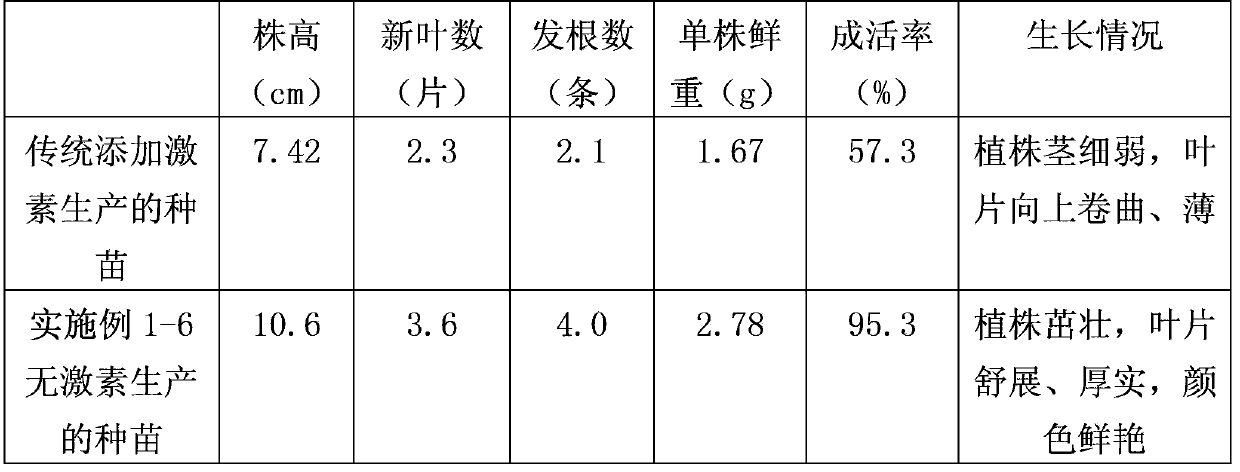Hormone-free tissue culture and rapid propagation method of anoectochilus formosanus seedlings
A tissue culture, hormone-free technology, applied in the agricultural field, can solve the problems of high production cost, uneven seedlings, unsafe and other problems, and achieve the effects of fast seedling growth, continuous production process, and easy operation
- Summary
- Abstract
- Description
- Claims
- Application Information
AI Technical Summary
Problems solved by technology
Method used
Image
Examples
Embodiment 1
[0041] Wild clematis plants were collected from Nanjing County, Fujian Province and planted in a net room. After several months of observation, selected excellent plants were selected for artificial cross-pollination at the flowering stage. After 55 days, the fruit was selected to be plump, hard, free of pests and diseases, and the color of the appearance was red. or light brown capsules for tissue culture. Place the selected capsules on a sterile ultra-clean workbench, soak them in 75% alcohol for 50 seconds, take them out and transfer them to a 10% sodium hypochlorite solution for disinfection for 9 minutes, then take them out and transfer them to a sterile container for use. Soak and wash with sterile water for 4 times, and finally take out the capsule and dry the surface moisture with sterile paper, and then culture according to the following four tissue culture stages:
[0042] (1) Aseptic germination of seeds to form protocorms: After disinfecting and sterilizing the sur...
Embodiment 2
[0051] Select fine clematis plants planted in the clematis planting base, carry out artificial cross-pollination on the third day of full flowering, and select capsules with plump, hard, no pests and diseases, and reddish-brown appearance color for tissue culture after 60 days . Place the selected capsules on a sterile ultra-clean workbench, soak them in 75% alcohol for 30 seconds, take them out and transfer them to a 15% sodium hypochlorite solution for disinfection for 8 minutes, then take them out and transfer them to a sterile container for use. Rinse with sterile water for 5 times, and finally take out the capsule and dry the surface moisture with sterile paper, and then culture according to the following four tissue culture stages:
[0052] (1) Aseptic germination of seeds to form protocorms: After disinfecting and sterilizing the surface of the capsules, cut the capsules, take out the seeds and sow them evenly on the hormone-free seed germination medium, and place the s...
Embodiment 3
[0061]Collected from Yunnan wild clematis naturally pollinated, plump, hard, no pest damage and light brown in appearance. Place the selected capsules on a sterile ultra-clean workbench, soak them in 75% alcohol for 60 seconds, take them out and transfer them to an 8% sodium hypochlorite solution for disinfection for 10 minutes, then take them out and transfer them to a sterile container for use. Soak in sterile water for 3 times, and finally take out the capsule and dry the surface water with sterile paper, and then culture according to the following four tissue culture stages:
[0062] (1) Aseptic germination of seeds to form protocorms: After disinfecting and sterilizing the surface of the capsules, cut the capsules, take out the seeds and sow them evenly on the hormone-free seed germination medium, and place the sown culture bottles at a temperature of 20-28°C Cultivate and induce seed germination under light-free conditions. After 30 days of cultivation, the seeds swell a...
PUM
 Login to View More
Login to View More Abstract
Description
Claims
Application Information
 Login to View More
Login to View More - R&D
- Intellectual Property
- Life Sciences
- Materials
- Tech Scout
- Unparalleled Data Quality
- Higher Quality Content
- 60% Fewer Hallucinations
Browse by: Latest US Patents, China's latest patents, Technical Efficacy Thesaurus, Application Domain, Technology Topic, Popular Technical Reports.
© 2025 PatSnap. All rights reserved.Legal|Privacy policy|Modern Slavery Act Transparency Statement|Sitemap|About US| Contact US: help@patsnap.com


